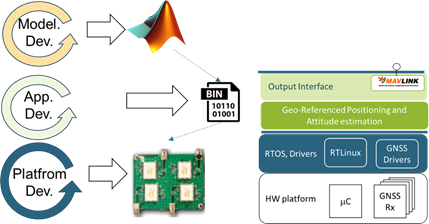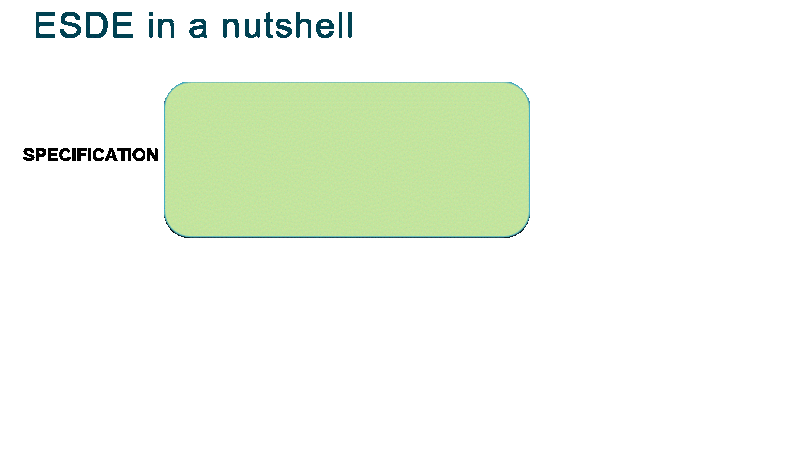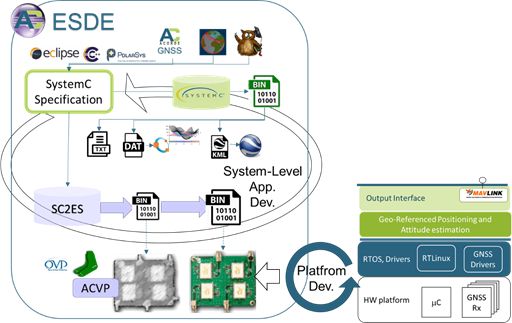WP6-ESDE
ESL embedded Software Design Environment (ESDE)
| ID | WP6-ESDE |
| Contributor | ACORDE |
| Levels | Tool, Platform |
| Require | Linux, Virtual Platform Development Platform |
| Provide | Executable System-Level modelling, automated embedded software generation, Virtual Platform based validation |
| Input | SystemC models, RTOS API target, Platform target, Platform model |
| Output | Functional and time performance validation. Close to production firmware generation and validation. |
| C4D tooling | n.a. |
| TRL | 4 |
In the past, for the design and development of a complete positioning and attitude solution like GLAD, ACORDE relied on a conventional design flow where a former hih-level model using Matlab was used. Then a manual translation was done to C++, which was tested on the final physical prototype. This type of flow is illustrated in the following picture:
Yet, this design flow is improvable in many aspects. While usable and proven, this approach yet presented some important disadvantages:
- Enforcing a sequential HW/SW development. HW/SW platform availability is a pre-condition for application development.
- Long simulation times and lacks on the modelling language (e.g., no time modelling)
- High translation effort from the high-level model (in Matlab) to the implementation language.
Contribution and Improvements
In order to overcome the previos drawbacks, ACORDE has worked in COMP4DRONES on an ESL embedded Software Design Environment (ESDE) for **better productivity in embedded system design and development, and specifically suited to positioning systems*. The basic idea of ESDE is summarized in the following illustration
ESDE enables some key features for productivity improvement:
- Building fast especifications/models, able to capture key concerns of the application (modularity, concurrency, time model) under a unified and standard language (SystemC).
- Executable specifications, able to significantly speed-up functional validation vs Matlab model execution.
- Automated embedded software generation mechanisms that avoid a significant translation effort from the system model to the implementation binary code.
- The possibility to develop the firmware in parallel with the HW development, by relying on a virtual platform.
- The possibility to validate the production firmware (or a very close version to it), on top of a virtual platform, as a digital twin of the final physical platform
Detailed Description
A bit more detailed description of the ESDE framework developed by ACORDE in COMP4DRONES is sketched in the following picture.
Status after C4D (Demos) and Future
In C4D, ESDE has been developped to support the especification a core functionality for attitude estimation (a multi-baseline attitude estimation or mbattes), in SystemC, which can be easily compiled into an executable model for its validation, as it is shown in this first demo video.
Moreover, ESDE allows the targeting of this SystemC specification onto C++ based implementation (as shown in a second video), which can be automatically produced to different targets. The targetting to a Linux-based platform supporting posix threads is illustrated on the following video, where the targeting of the mbattes SystemC specification is targeted to a Linux-based target, to generate an implementation (executable file), which is launched on a PC
In this clip, the final result of the execution shows the correctness of the implementation.
ESDE remains as a live project in ACORDE, which as well as positioning systems, have potential to highly improve embedded development productivity. Currently, extensions for generic procedures for traceability to enable performance analysis based on the VP target.
Interoperability
ESDE models are written in standard SystemC. The implementations target standard C++. For implementing RTOS services, it currently uses either POSIX API or FreeRTOS API.
System-Level application models relie on modules, channels, processes elements, which facilitates mapping with other C4D frameworks, like S3D. This has been tested for the mbattes example in a collaboration between ACORDE and the University of Cantabria.


